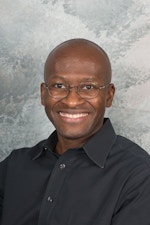Shawn Raynard Hitchcock

- About
- Education
- Awards & Honors
- Selected Research
Biography
Went to Wayne State University for BS in chemistry (1990). Attended UC Davis for PhD (1995). Completed post-doctoral study at UW Madison.
Current Courses
CHE 299.010 Independent Honor Study In Chemistry
CHE 499.010 Independent Research For The Master's Thesis
CHE 287.001 Independent Study
CHE 233.002 Organic Chemistry Laboratory II
BSC 290.058 Research In Biological Sciences
CHE 290.010 Research in Chemistry
CHE 490.010 Research In Chemistry
CHE 380.001 Structural Determination In Chemistry
CHE 480.001 Topics in Chemistry: Structural Determination In Chemistry
Teaching Interests & Areas
My teaching interest in organic chemistry. I have taught courses in sophomore organic chemistry, graduate organic chemistry, and special topics in carbon-carbon bond forming reactions and stereochemistry. CHE 230: The course is offered as the first in a two-course sequence in a yearlong study of organic chemistry. This course serves to build a strong foundation in the science of organic chemistry for students preparing for careers in the chemical industry, academia, medicine, pharmacy or other health related fields. The class was built about a foundation of lectures, interactive class participation, video presentations and demonstrations that focused on the art and science of organic chemistry. CHE 232: CHE 232 is offered as the final course in a two-course sequence of organic chemistry and is required for majors. The class builds upon the foundations and introduces new concepts that are directly related to biology and biochemistry. These elements usually bring in the interest of the undergraduates because it is such an interdisciplinary focus. CHE 380.51: CHE 380.51 is a course that is designed to meet the needs of graduate and undergraduate students. The class is a transitional course that helps undergraduate students and graduate students reinforce the basics that were learned during the sophomore year in college. I have always believed that the establishment of the fundaments is critical. The examples that are drawn from in class are taken from the immediate chemical literature. CHE 426: CHE 426 is a class meant to help undergraduate and M.S. graduate students gain of strong understanding of organic chemistry beyond the undergraduate experience. The class covers a number of subjects that are important in contemporary organic synthesis. Many graduate students often tell me that CHE 426 was one of their best classes that they have taken during their graduate career.
Research Interests & Areas
My research interest in the field of molecular asymmetry. As we move into the 21st century, the needs of society change and evolve. The pharmaceutical industry is changing as well. The emerging challenges in the pharmaceutical filed involve many different aspects. One of these aspects is molecular chirality, the capacity of certain molecules to exist as right-handed and left-handed versions. The global sales of such chiral drugs are currently greater than $150 billion per year. Many of these medicinal agents are selectively prepared as either the "right-handed" form or the "left-handed" form as they can exhibit different biological effects. My research has been focused on developing a variety of methods for the selective preparation of single enantiomer materials. In 2004, funding from the Petroleum Research Fund (administered by the ACS) has allowed me to work with a variety of graduate and undergraduate students in developing a class of chemical reagents capable of inducing the selective formation of chiral materials. The successes and challenges associated with the oxadiazinones led to emergence of a new research program focused on the use of asymmetric catalysts. The catalysis work led to the establishment of a patent for a method that was developed for the Ephedra alkaloid known as pseudonorephedrine. This work was primarily led by Jonathan Groeper. Before this patent work, pseudonorephedrine was commercially available for nearly $16,800 per gram. This work makes the cost of the material about $20 per gram. Sigma-Alrich also saw the value of his compound and has recently developed irs own synthetic procedure to make this material available. We also developed several new classes of chiral catalysts called oxazolidines, oxadiazines and beta-hydroxysalicylhydrazones. These catalysts have shown promise in the application in trials of the asymmetric 1,2-addition of diethylzinc to aromatic and aliphatic aldehydes. This pilot work led to my research group successfully securing a grant from the National Science Foundation in 2007 for $226,050. This grant is being used to increase the diversity of chemical methods that my research group employs in the search for methods of the very selective formation of chiral molecules. Working with a lead graduate student, Raleigh Parrott, an undergraduate student Seshanand Chandrashekar, and high school student Brittany Morgan, we have just published our results of an effective tridentate catalyst in the journal Tetrahedron: Asymmetry. We have developed several families of ligands that already show much promise in terms of their use in reactions such as the asymmetric allylic alkylation reactions. One of our current targets that we are nearing completion on is the medicinal agent leveteracitam, a clinically effective treatment for epilepsy. In addition to this work, we have developed several families of ligands that already show much promise in terms of their use in reactions such as the asymmetric allylic alkylation reactions. In conjunction with my research activities, I am constantly developing my mentoring activities with my research students. The activities include weekly meetings where students learn about finding, applying for, and securing positions in the chemical industry. Students who have worked with me in carrying out studies on chiral materials are employed around the country at companies such as Alcon Laboratories (Texas), Amgen (California), Anderson & Associates (Illinois), DeCode Laboratories (Illinois), GlaxoSmithKline (Pennsylvania). Jonathan Groeper, a 2007 graduate is now employed at Merck Research Laboratories (New Jersey) and Raleigh Parrott II, another 2007 graduate is working with the Federal Bureau of Investigation (Virginia).